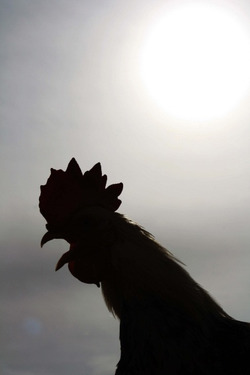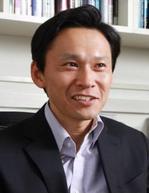 Professor Takashi Yoshimura1 and Dr. Tsuyoshi Shinmura2 of Nagoya University have discovered the mechanism that drives a rooster's crow, and their paper was published in Current Biology on 18th March, 2013. The research appears on the cover of the issue and in various other media, and is receiving attention around the world.
Professor Takashi Yoshimura1 and Dr. Tsuyoshi Shinmura2 of Nagoya University have discovered the mechanism that drives a rooster's crow, and their paper was published in Current Biology on 18th March, 2013. The research appears on the cover of the issue and in various other media, and is receiving attention around the world.
Everyone knows that roosters crow before dawn, yet no-one has demonstrated the mechanism. Firstly, the research group put roosters under light (subjective day) and dim light (subjective night) for 12 hours respectively, and recorded their crowing cycle. As a result, crowing was observed 2 to 3 hours before the onset of light. Next, roosters were put under dim light at all times, and this showed that they crow at 23.7 hour periods. The influence of external stimuli was also examined, and it was proved that given light or sound at various times of day, roosters also crow just before the subjective day begins.
The research proves that the rooster breaks the dawn every morning as a function of his circadian clock, and crowing induced by external stimuli is also regulated by the biological clock.
1. Professor at the Institute of Transformative Bio-Molecules, Nagoya University.
2. Post Doctoral Researcher, Laboratory of Animal Physiology, Nagoya University.
Professor Takashi Yoshimura
Professor Takashi Yoshimura identified a gene regulating photoperiodism in birds and mammalian species, a function to sense seasonal change, for the first time in the world. His interest is in the underlying mechanisms of an innate vocalization, and in the course of studying the regulatory gene of the well-known 'cock-a -doodle-doo', he found out how roosters know when to crow.
Outlook for the Future[
"Hereafter I would like to expand this research to gain a further understanding of animal vocal communication."
Message to Young Students
 Through my research, I am constantly amazed at the survival strategies of living creatures. Why not join us and pursue the study of animal life? "
Through my research, I am constantly amazed at the survival strategies of living creatures. Why not join us and pursue the study of animal life? "
Links
Research Information
Professor Takashi Yoshimura Information